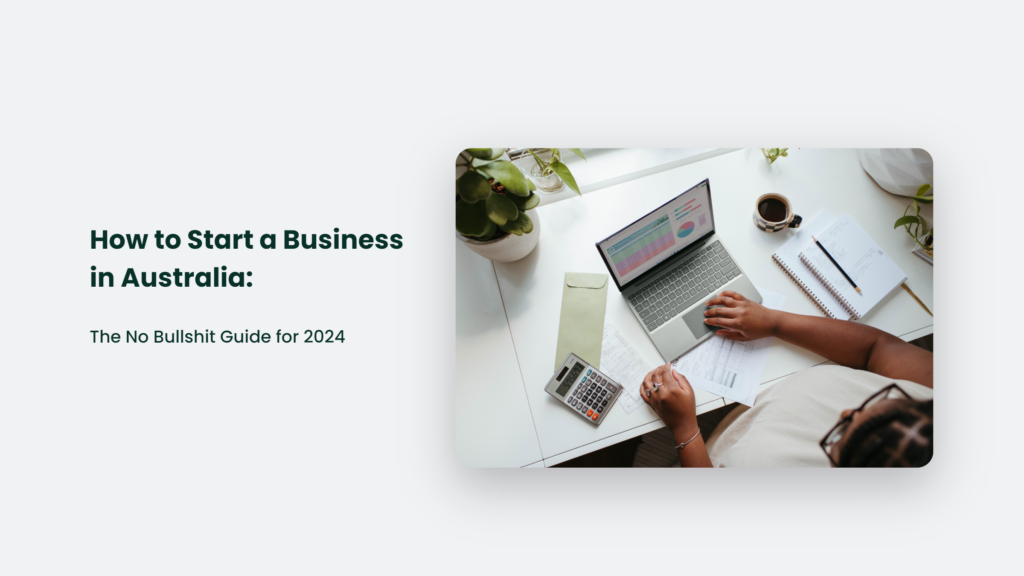

How to Start a Business in Australia: The No Bullshit Guide for 2024

As Seen On
So, you want to start a business in Australia? Join the club. Over 2 million Aussies are small business owners chasing their dreams of being their own boss.
But here’s the thing – most new businesses fail within the first few years. Why? Because starting a business is fucking hard. There’s a ton of bullshit advice out there that glosses over the blood, sweat and tears it takes actually to succeed.
Well, I’m here to give it to you straight. It is the no-bullshit guide on how to start a business in Australia in 2024.

Why Most Advice on Starting a Business is Bullshit
Flip through any business book or blog, and you’ll find the same recycled, rah-rah advice: “Just follow your passion!”
Take that leap of faith!” “Success is just around the corner!” Look, passion and optimism are great. But they won’t pay your bills or put food on the table. The truth is, passion alone won’t cut it. Starting a successful business takes grit, perseverance and a shit-ton of hard work.
Most “experts” won’t actually tell you the nitty-gritty of what it takes. So I’m going to give it to you straight, no chaser.
Here’s how to start a business in Australia:
Step 1: Validate Your Business Idea
Coming up with a brilliant business idea is the easy part. The hard part is knowing if that idea will actually work in the real world.
Before you invest time and money, you need to validate your idea. Here are 3 ways to test if your business idea will fly or flop:
Conduct Market Research
Market research will tell you about the demand for your product or service. Here are a few innovative ways to conduct market research:
- Google Keyword Planner: See search volume for relevant keywords
- Google Trends: Identify trends and seasonality
- Industry Reports: Get market size, growth projections, trends
- Competitor Analysis: Research competitors’ offerings and pricing
Create a Minimum Viable Product
A minimum viable product (MVP) is a stripped-down version of your product. The goal is to test it with customers and get feedback early on.
Some examples of MVPs:
- Landing page with a “Buy Now” button
- Basic software demo
- 3D printed prototype
- Explainer video
Presell Your Product
Preselling lets you validate demand before investing in full production. Some preselling tactics:
- Crowdfunding campaign
- Pre-order campaign
- Membership site
You know you’re onto something if you can get at least 50 pre-orders or signups.
Step 2: Choose a Business Structure
Your business structure determines legal liability, taxes and record-keeping requirements. Here are the main options for Australian businesses:
Step 2: Choose a Business Structure
Your business structure determines things like legal liability, taxes and record-keeping requirements. Here are the main options for Australian businesses:
Sole Trader
A sole trader is the simplest business structure. There’s minimal setup, but you’re personally liable for debts and losses.
Partnership
A partnership splits ownership between 2 or more people. You share profits, losses and legal liability. Partnerships require a formal partnership agreement.
Company
A company is a separate legal entity from the owner. You’re not personally liable for company debts. But there’s more compliance involved.
Trust
A trust separates control of assets from beneficiaries. The trustee controls the assets of the beneficiaries. Trusts can help with asset protection and tax planning.
Speak with your accountant to determine the best structure for your business.
Step 3: Register Your Business
To make your business “official,” you must register it with the government. Here are the key registrations:
- ABN: All businesses need an Australian Business Number (ABN). It is for dealing with the tax office.
- Business Name: Register your business name to trade under a specific name.
- Domain Name: Buy your .com.au domain to establish your brand online.
- GST: Register for GST if your revenue exceeds $75k per year.
- Payroll Tax: Register for payroll tax if your payroll exceeds the threshold in your state.
Step 4: Get Business Licenses and Permits
Depending on your industry, you may need special licenses and permits to operate legally in Australia. For example:
- Food businesses need a food handling permit.
- Tradespeople need licenses for their profession.
- Healthcare providers need registration with AHPRA.
- Childcare centres need licenses to operate.
Search “[industry] license Australia” to find permits specific to your business.
Step 5: Find a Location
Your business location can make or break your success. Here are some tips for picking the right location:
Home-Based: Operating from home minimizes costs but may limit growth.
Coworking Space: Shared workspaces offer flexibility and networking opportunities.
Retail Shop: Consider foot traffic, parking, public transport and surrounding businesses.
Warehouse: Look at proximity to transport routes if you’ll be distributing products.
Office: Your location should match the prestige level of your business.
Online: Some businesses can operate 100% virtually to minimize overhead costs.
Step 6: Set Up Your Finances
You’ll need to get your finances in order before opening for business. Here are some must-dos:
- Business Bank Account: Keep your business and personal finances separate.
- Accounting Software: Use software like Xero or MYOB for invoicing, reporting, etc.
- Credit Card: Use a business credit card for purchases to keep expenses separate.
- Insurance: Get public liability insurance at a minimum. Consider professional indemnity and other coverage.
- Finance: Explore loans, angel investments and grants to fund your venture if needed.
Step 7: Hire Your Team
You can’t do everything yourself. Building a solid team will help your business thrive.
Employees vs Contractors
Employees are ongoing staff entitled to minimum pay and leave. Contractors are hired for specific projects. Choose whichever works best.
Where to Find Talent
Post jobs on platforms like Seek, LinkedIn and industry job boards. You can find contractors on Airtasker, Fiverr and Upwork.
Manage Your Team
Use HR software like Employment Hero for onboarding, payroll, performance reviews and leave management.
Step 8: Promote and Market Your Business
You must get the word out so customers find and buy from you. A few proven tactics:
- SEO: Rank your website higher on Google with search engine optimization.
- Google Ads: Pay for PPC ads to get immediate results.
- Social Media: Leverage platforms like Facebook, Instagram and LinkedIn.
- Content Marketing: Attract customers by publishing valuable content.
- Email Marketing: Collect emails to build an audience for promotions.
- PR: Earn media coverage through press releases and pitches.
Step 9: Deliver 5-Star Service
Exceeding customer expectations is key to growing a loyal customer base. Ways to wow customers:
- Respond quickly: Answer emails and social media messages promptly.
- Be transparent: Clearly communicate shipping times, policies, etc.
- Go the extra mile: Include handwritten notes or surprise-free gifts.
- Ask for reviews: Reviews boost credibility and SEO.
- Handle problems: Fix mistakes quickly and own up to errors.
Step 10: Analyze and Improve
Successful entrepreneurs constantly look for ways to improve. Some metrics and tools to track:
- Sales and revenue: Monitor your key financial metrics.
- Web analytics: Use Google Analytics to see website traffic sources.
- Rank tracking: Monitor keyword rankings with tools like SEMrush.
- Surveys: Ask for customer feedback through surveys.
- Reviews: Solicit reviews on Google, Facebook and industry sites.
Frequently Asked Questions:
What legal requirements are there to start a business in Australia?
The legal requirements include choosing a business structure, registering for an ABN and business name, potentially registering for GST and payroll tax, and getting the necessary licenses for your industry.
How much does it cost to start a business in Australia?
Costs vary widely based on the type of business. Budget for registration and compliance fees, licenses, website development, marketing, insurance, inventory and other expenses. Have at least 6 months of living expenses saved as a buffer.
What legal requirements are there to start a business in Australia?
The legal requirements include choosing a business structure, registering for an ABN and business name, potentially registering for GST and payroll tax, and getting the necessary licenses for your industry.
The Truth About Starting a Business in Australia
So there you have it – the real truth about starting a business in Australia.
As you can see, it takes more than passion and a great idea. It requires months or years of grit, sweat and toil before you see a cent of profit.
But the payoff of being your boss and turning your vision into reality makes it all worthwhile.
Sure, there will be roadblocks and setbacks around every corner. But many others have succeeded before you, and so can you.
Now get out there, work your ass off, and make it happen!
Gracie Jones
Up until working with Casey, we had only had poor to mediocre experiences outsourcing work to agencies. Casey & the team at CJ&CO are the exception to the rule.
Communication was beyond great, his understanding of our vision was phenomenal, and instead of needing babysitting like the other agencies we worked with, he was not only completely dependable but also gave us sound suggestions on how to get better results, at the risk of us not needing him for the initial job we requested (absolute gem).
This has truly been the first time we worked with someone outside of our business that quickly grasped our vision, and that I could completely forget about and would still deliver above expectations.
I honestly can’t wait to work in many more projects together!
Disclaimer
*The information this blog provides is for general informational purposes only and is not intended as financial or professional advice. The information may not reflect current developments and may be changed or updated without notice. Any opinions expressed on this blog are the author’s own and do not necessarily reflect the views of the author’s employer or any other organization. You should not act or rely on any information contained in this blog without first seeking the advice of a professional. No representation or warranty, express or implied, is made as to the accuracy or completeness of the information contained in this blog. The author and affiliated parties assume no liability for any errors or omissions.

